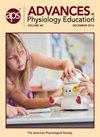A Partially Flipped Physiology Classroom Improves the Deep Learning Approach of Medical Students
IF 1.7
4区 教育学
Q2 EDUCATION, SCIENTIFIC DISCIPLINES
引用次数: 0
Abstract
This study aimed to compare the impact of the partially flipped physiology classroom (PFC) and the traditional lecture-based classroom (TLC) on students' learning approaches. The study was conducted over five months at Xiangya School of Medicine from February to July 2022 and comprised 71 students majoring in clinical medicine. The experimental group (n = 32) received PFC teaching, while the control group (n = 39) received TLC. The Revised Two-Factor Study Process Questionnaire (R-SPQ-2F) was used to assess the impact of different teaching methods on students' learning approaches. After the PFC, students got significantly higher scores on deep learning approach (Z=-3.133, P<0.05). Conversely, after the TLC, students showed significantly higher scores on surface learning approach (Z=-2.259, P<0.05). After the course, students in the PFC group scored significantly higher in deep learning strategy than those in the TLC group (Z=-2.196, P<0.05). The PFC model had a positive impact on the deep learning motive and strategy, leading to an improvement in the deep approach, which is beneficial for the long-term development of students. In contrast, the TLC model only improved the surface learning approach. The study implies that educators should consider implementing PFC to enhance students' learning approaches.部分翻转的生理学课堂改进了医学生的深度学习方法
本研究旨在比较部分翻转生理学课堂(PFC)和传统讲授式课堂(TLC)对学生学习方法的影响。研究于2022年2月至7月在湘雅医学院进行,历时5个月,共有71名临床医学专业的学生参加。实验组(32 人)接受 PFC 教学,对照组(39 人)接受 TLC 教学。采用修订的双因素学习过程问卷(R-SPQ-2F)来评估不同教学方法对学生学习方法的影响。在 PFC 之后,学生在深度学习方法上的得分明显提高(Z=-3.133,P<0.05)。相反,在 TLC 之后,学生在表层学习方法上的得分明显更高(Z=-2.259,P<0.05)。课程结束后,PFC 组学生的深度学习策略得分明显高于 TLC 组(Z=-2.196,P<0.05)。PFC模式对深度学习动机和策略产生了积极影响,导致了深度学习方法的改进,有利于学生的长远发展。相比之下,TLC 模式只改善了表层学习方法。该研究表明,教育工作者应考虑实施 PFC,以提高学生的学习方法。
本文章由计算机程序翻译,如有差异,请以英文原文为准。
求助全文
约1分钟内获得全文
求助全文
来源期刊
CiteScore
3.40
自引率
19.00%
发文量
100
审稿时长
>12 weeks
期刊介绍:
Advances in Physiology Education promotes and disseminates educational scholarship in order to enhance teaching and learning of physiology, neuroscience and pathophysiology. The journal publishes peer-reviewed descriptions of innovations that improve teaching in the classroom and laboratory, essays on education, and review articles based on our current understanding of physiological mechanisms. Submissions that evaluate new technologies for teaching and research, and educational pedagogy, are especially welcome. The audience for the journal includes educators at all levels: K–12, undergraduate, graduate, and professional programs.

 求助内容:
求助内容: 应助结果提醒方式:
应助结果提醒方式:


